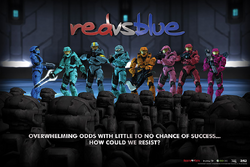- "In the distant future, two groups of soldiers battle for control of the least desirable piece of real estate in the known universe: a box canyon in the middle of nowhere."
- —Series description
Red vs. Blue, often abbreviated as RvB, is a science-fiction comedy web television series created by Burnie Burns and produced by Rooster Teeth. It focuses on the lives and adventures of the Reds and Blues from a box canyon known as Blood Gulch. With over 300 episodes and more still currently in production, Red vs. Blue is the longest running episodic web television series ever. Of all time.
Production
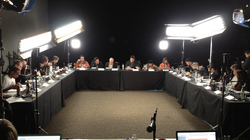
The Red vs. Blue cast reading their lines.
The writing process for the series has changed over time. Early in season 1, Burns wrote the episode scripts from week to week, with minimal planning in advance; major plot events were conceived shortly before they were filmed.[1] For the second season, Matt Hullum became a main writer.[2] A rough plot outline is now written before a season begins, although the actual content of an individual episode is still decided on a more short-term basis.[3] Because Red vs. Blue is loosely based on the Halo universe, Rooster Teeth encountered some difficulties when trying to synchronize events in the series with the release of Halo 2.
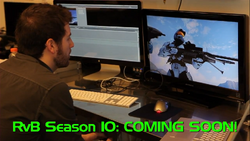
Red vs. Blue: Season 10 production
Aside from a few scenes created using Marathon Infinity, Marathon 2, and the PC version of Halo, Red vs. Blue is mostly filmed with interconnected Xbox consoles. Originally using the Halo: Combat Evolved engine, it has since been filmed using four sequels and one prequel of the popular game: Halo 2, Halo 3, Halo 4, Halo: Reach, and Halo 5: Guardians as well as utilized Computer Generated Imagery. During The Blood Gulch Chronicles, episodes were largely set in the Halo map Blood Gulch and its Halo 2 counterpart, Coagulation while some episodes were filmed on other maps, including Sidewinder from Halo and Zanzibar from Halo 2. After The Blood Gulch Chronicles had ended, they began using more locations within later games, such as Valhalla from Halo 3 and Exile from Halo 4. Within a multiplayer game session, the people controlling the avatars "puppet" their characters, moving them around, firing weapons, and performing other actions as dictated by the script, and in synchronization with the episode's dialogue, which is recorded ahead of time.
The "camera" during the first four seasons was simply another player, whose first-person perspective is recorded raw to a computer. As the recording occurs within the game, a few different bugs and post-production techniques have been exploited in order to achieve desired visual effects. In particular, Adobe Premiere Pro is used to edit the audio and video together, impose letterboxing to hide the camera player's head-up display, add the titles and fade-to-black screens, and create some visual effects that cannot be accomplished in-game.[4] For Season 5, the PC version of Halo 2 was used to film episodes, making use of detaching the camera. From Reconstruction onward, Halo 3's (along with its sequels/prequels) theater mode was utilized for shooting scenes that were more difficult to achieve using previous titles.
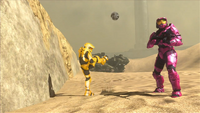
An example of the blend between gameplay and character animation as seen in Revelation.
In 2009, Monty Oum was hired to work on minor special effects in Recreation, most notably Epsilon's laser beam in Think You Know Someone.[5] During the production of Revelation, Monty began working on animating the Red vs. Blue characters in Computer Generated Imagery, which was blended within Halo 3 by Nathan Zellner and Matt Hullum. Since then, Rooster Teeth has moved to a new office building with a whole empty storage room, used for motion capture. Rooster Teeth also currently have a full team of animators working on Red vs. Blue's animation, alongside Monty Oum. They have produced the Poser animation for Season 9 and Season 10.
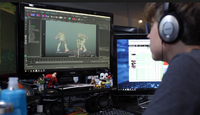
Production on Red vs. Blue: The Shisno Paradox
During the production of the third saga, Rooster Teeth Productions decided to employ a new writer to the series. Around 2012, Miles Luna became the writer of Red vs. Blue, who has written for the Where There's a Will, There's a Wall mini-series and Season 10, did the next three seasons, The Chorus Trilogy. For Season 12, Chris Dike was hired to take over for the series' additional animation, which was blended with the in-game engine similar to Revelation. The full animation staff returned for Season 13 but did not return for the following seasons. Not knowing how to continue the cliffhanger set by the ending of Season 13, Rooster Teeth decided to make Season 14 an anthology with many writers, serving as an unofficial audition for the next showrunner. After writing The Brick Gulch Chronicles for Season 14, Joe Nicolosi was chosen to helm Season 15 and The Shisno Paradox. Jason Weight was brought on to co-write The Shisno Paradox and was later chosen to write Singularity while machinimators Joshua Ornelas and Austin Clark were promoted to directors.
For Zero, Torrian Crawford was brought on to helm the season as director and showrunner for the series.
Main Characters
- Main article: List of Characters
- Main article: List of Appearances
Reds and Blues
- Super Colonel Sarge (Season 1-present)
- Captain Richard "Dick" Simmons (Seasons 1-8; 10-present)
- Captain Dexter Grif (Season 1-present)
- Private Franklin Delano Donut (Seasons 1-5; Relocated-8; 10-present)
- Lopez the Heavy (Seasons 1-7; 10-present)
- Captain Lavernius Tucker (Seasons 1-8; 10-present)
- Captain Michael J. Caboose (Season 1-present)
- Kaikaina "Sister" Grif (Seasons 5-6; 13-present)
- Agent Washington (Recovery One-present)
- Agent Carolina (Season 9-present)
- Medical Officer Super Private First Class Frank "Doc" DuFresne (Seasons 2-5; 8; 10-11; 13-present)
- Private Leonard L. Church (Seasons 1-6; 9-10; 14-15; 17)
- Agent Texas (Seasons 1-6; 9-10; 14; 17)
- Sheila (Seasons 1-6; 14; 17)
- Epsilon (Recovery One-Season 14; 17)
- Tex II (Seasons 8-9; 14)
Shatter Squad
- Agent West (Season 18-present)
- Agent East (Season 18-present)
- Agent One (Season 18-present)
- Agent Axel (Season 18-present)
- Agent Raymond (Season 18-present)
Zero's Syndicate
Story Arcs
The Blood Gulch Chronicles
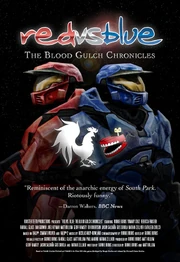
The poster for the original series.
The Blood Gulch Chronicles is the first main saga in the Red vs. Blue series, spanning 5 seasons, 100 episodes, and a 5-part mini-series.
The Recollection
The Recollection is the second saga in the main series. It includes Reconstruction, Recreation, and Revelation—seasons six, seven, and eight respectively. It also includes two mini-series: Recovery One and Relocated.
The Project Freelancer Saga
The Project Freelancer Saga is the third main saga of the series, spanning two seasons and two mini-series. Unlike the previous two sagas, however, the Project Freelancer saga focuses on prequel events taking place before The Blood Gulch Chronicles, as well as present-day events.
The Chorus Trilogy
The Chorus Trilogy is the fourth main saga of the series and takes place after the present-day events of Season 10. The story focuses on the Reds and Blues shipwrecked on a long forgotten planet and unexpectedly becoming involved in the planet's civil war.
The Shisno Trilogy
The Shisno Trilogy is the fifth main saga of the series and takes place ten months after The Chorus Trilogy. The story focuses on the Reds and Blues getting themselves involved in an intergalactic conflict after being brought out of retirement by a reporter.
Zero
A mysterious syndicate leader known only as Zero seeks an Ultimate Power and a ragtag team of heroes and misfits called Shatter Squad must work together to save the galaxy.
Reception
Impact on Machinima
Red vs. Blue is widely credited with attracting public attention to Machinima. Although examples had existed since the 1990s, Clive Thompson credits Red vs. Blue as "the first to break out of the underground".[6] Tavares, Gil, and Roque call it Machinima's "first big success".[7] Thompson notes that "Microsoft has been so strangely solicitous that when it was developing the sequel to Halo last year, the designers actually inserted a special command — a joystick button that makes a soldier lower his weapon — designed solely to make it easier for Rooster Teeth to do dialogue." The series has inspired other machinima productions, including The Codex, Fire Team Charlie, and This Spartan Life.[8]
Impact on Video Games
Due to the series' large and growing popularity, many within the video game industry have made reference to the web-series numerous times. For example, the Halo franchise has referenced the series' characters and recurring jokes in many of its games, as well as hiring Rooster Teeth Productions to promote their products through the web-series. Critics have even stated Red vs. Blue to have amazing character development which other media should take an example of.
Trivia
- Red vs. Blue was originally intended to last only six episodes, but its popularity led to the production of over three-hundred, with separate seasons.
- Currently, only ten characters have appeared in 100 or more episodes in the series, which are: Caboose, Simmons, Grif, Sarge, Tucker, Donut, Church, Epsilon, Lopez, and Washington. Tex has surpassed the barrier if combined with her Epsilon duplicate.
- Throughout the series, each of the main cast, with the exceptions of Washington and Sister, has sung in either an official episode, a special episode, a PSA, and/or an official season soundtrack.
- Sarge: There Goes The Neighborhood, Sarge's Blues, Voting Fever, A Red vs. Blue Holiday Special, Red vs. Blue: The Musical
- Grif: Voting Fever, Red vs. Blue: The Musical
- Simmons: Voting Fever, Red vs. Blue: The Musical
- Donut: Donut: The Musical, Red vs. Blue: The Musical
- Lopez: An Audience of Dumb, Red vs. Blue: The Musical
- Carolina: Epilogues
- Church: Red vs. Blue: The Musical
- Epsilon: I Am The Best
- Tucker: Bow Chicka Wow Wow Wow, Red vs. Blue: The Musical
- Caboose: Your Best Friend, Red vs. Blue: The Musical, Caboose's Guide to Finding Your Home
- Sheila: Red vs. Blue: The Musical
- Doc: Red vs. Blue: The Musical
- Sarge, Caboose, and Grif are currently the only characters in the series that have made an appearance in every season (Note: Grif makes a vocal appearance in Season 9, rather than a physical one).
- Coincidentally, they are also the only characters featured in the PSA Sleeper, where Grif again only has a vocal appearance rather than a physical one.
- Caboose, Church, Simmons and Grif are currently the only characters in the series to appear in all types of animation forms used in Red vs. Blue (machinima, 2D animation, CG animation, and stop-motion).
- The latter two also currently have the longest series lifespan than any other character, with both being first introduced in the Red vs. Blue Trailer.
- Most main human antagonists have a relation to the color white, as Wyoming's armor is entirely white, the Meta's primary armor color is white, the Insurrectionist Leader has white trim when using C.T.'s armor, and the Director has white streaks in his hair and is in command of Project Freelancer (its signature color is white). The only exceptions are the Chairman, Locus, and Felix, who have more of a relation to the color steel (black). This is referenced by Sarge in Reacts.
- Every season finale, so far, contains a plot twist, except for saga-ending seasons (Season 5, Revelation, Season 10, Season 13, and Singularity), and the standalone Season 15.
- Season 1: Omega escapes death by infecting Caboose.
- Season 2: Doc/Omega kidnaps Lopez and the Reds and Blues work together to stop him before being sent across the galaxy.
- Season 3: The Reds re-discover Blood Gulch and the Alien is seen.
- Season 4: Junior is born and a Pelican lands on Donut.
- Reconstruction: Church is revealed to be based on Director Leonard Church.
- Recreation: Washington teams up with Meta and shoots Donut and Lopez.
- Season 9: Carolina is revealed to be alive after her supposed death.
- Season 11: Carolina is revealed to have secretly contacted Locus without his knowledge.
- Season 12: The identity of Control is Malcolm Hargrove, who not only recovered F.I.L.S.S. but is also in possession of the Meta's helmet.
- The Shisno Paradox: Genkins is revealed to have been stringing the Reds and Blues along during the entire season, starting with erasing pizza from existence.
- Despite the series being called "Red vs Blue," the show hasn't been about the Reds and Blues fighting since Season 7. They've even merged the teams into one self made faction.
- The Chorus Trilogy and The Shisno Paradox are the only sagas in the series that does not contain a mini-series. The former are also the only saga to end on a cliffhanger.
- Some of the voice actors from Red vs. Blue were featured in the level Crow's Nest in Halo 3, as two Marines arguing over a password. The voices vary depending on difficulty: Jason Saldaña (Tucker) and Matt Hullum (Doc) on Easy and Normal; Geoff Ramsey (Grif) and Gus Sorola (Simmons) on Heroic; Burnie Burns (Church) and Joel Heyman (Caboose) on Legendary. Sarge cameos on the level Tsavo Highway as the radio operator's voice, just before the tunnel prior to where the Pelican drops off the Warthogs.
- Several Red vs. Blue actors also appear throughout the Halo: Reach campaign as marines, with Geoff Ramsey on Sword Base, and Burnie Burns on The Package, among others.
- In both Halo 3 and Halo: Reach, "Puma" can be read on the wheels of a Warthog.
- In the expansion pack for the video game Red Dead Redemption: Undead Nightmare, there is an achievement called "Chupathingy," when a player kills a Chupacabra, a reference to Red Gets a Delivery.
- In the game The Dishwasher: Vampire Smile, there is an achievement called "Bleep Bloop", in reference to Caboose's self-created achievements in the Small Rewards PSA.
- In the game Gears of War, there is an achievement entitled "Is it a Spider?", awarded for sticking 100 enemies with a grenade in multiplayer, a reference to the episode Knock, knock. Who's there? Pain.
- The series inspired the creation of the Halo 3, Halo: Reach, and Halo 4 game-type Grifball, based off the statement made by Sarge in Episode 59.
- In Halo 4, several characters make voice-only, cameo appearances as Easter Eggs in the Spartan Ops campaign when finding hidden boxes. When shot, the boxes play a segment of Blood Gulch Blues and cause different audio segments to be heard than in the normal campaign.
- There is a reference to Red vs. Blue in Windows 10. It can be found by simply asking the server's virtual assistant Cortana (itself based on Master Chief's AI from Halo) if she watches the show. The latter will reply saying "You know, I do sometimes wonder why we're here".
- It was revealed at RTX Sydney 2018 that the reason the characters have helmet voice filters is because Gustavo Sorola, the voice of Simmons, had moved to Puerto Rico when the show started production and had to record audio over the phone, leading creator Burnie Burns to add the filter to everyone else to keep the audio consistent.
- In the Dr. Weller character reveal trailer for gen:LOCK, an upcoming Rooster Teeth show, Florida can be seen destroyed on a map of the United States just as it was destroyed in Red vs. Blue.[9]
- In the second episode of gen:LOCK, Sinclair asks Valentina "If you don't think you can win, why are you here?" to which Cammie answers "It's one of life's greatest mysteries, isn't it?" This is an obvious reference to Why Are We Here?, the first episode of Red vs. Blue.
- In the sixth episode, Dr. Weller asks Julian "You ever wonder why we're here?", the other part of the series' opening dialogue.
Sources
- ↑ Burns, et al., Red vs. Blue Season One, Audio Commentary.
- ↑ Burns and Hullum, Red vs. Blue Season Two, Audio Commentary.
- ↑ Konow, 3.
- ↑ Burns, et al., Red vs. Blue Season One, Audio Commentary; Moltenbrey.
- ↑ Red vs. Blue: Revelation, Audio Commentary.
- ↑ Thompson, 2.
- ↑ Tavares, Gil, & Roque, 4.
- ↑ Whitley
- ↑ gen:LOCK Character Reveal Teaser #2 | Rooster Teeth
External links
- Red vs. Blue - Official site
- The Unofficial Red vs Blue Resource Site
- The Cult of Red vs Blue - News article
- Wikipedia Article
- Fan Art

